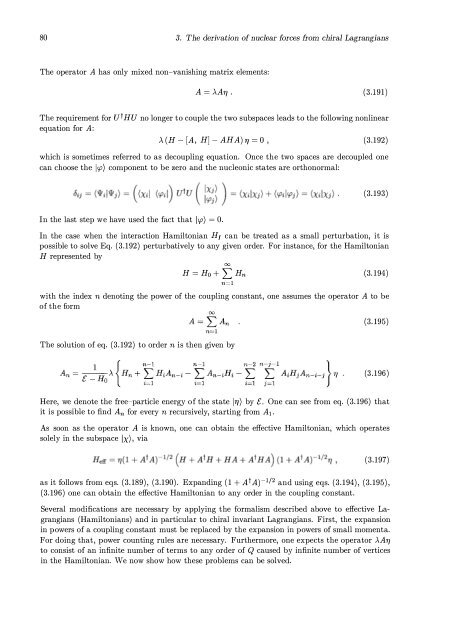The Nucleon-Nucleon Interaction in a Chiral Effective Field Theory
The Nucleon-Nucleon Interaction in a Chiral Effective Field Theory
The Nucleon-Nucleon Interaction in a Chiral Effective Field Theory
You also want an ePaper? Increase the reach of your titles
YUMPU automatically turns print PDFs into web optimized ePapers that Google loves.
80 3. <strong>The</strong> derivation of nuclear forces from chiral Lagrangians<br />
<strong>The</strong> operator A has only mixed non-vanish<strong>in</strong>g matrix elements:<br />
A = >'A1] . (3.191)<br />
<strong>The</strong> requirement for ut HU no longer to couple the two subspaces leads to the follow<strong>in</strong>g nonl<strong>in</strong>ear<br />
equation for A:<br />
>. (H - [A, H] - AHA) 1] = 0 , (3.192)<br />
which is sometimes referred to as decoupl<strong>in</strong>g equation. Once the two spaces are decoupled one<br />
can choose the Icp) component to be zero and the nucleonic states are orthonormal:<br />
(3.193)<br />
In the last step we have used the fact that Icp) = o.<br />
In the case when the <strong>in</strong>teraction Hamiltonian Hf can be treated as a small perturbation, it is<br />
possible to solve Eq. (3.192) perturbatively to any given order. For <strong>in</strong>stance, for the Hamiltonian<br />
H represented by<br />
00<br />
H=Ho + LHn n==l<br />
(3.194)<br />
with the <strong>in</strong>dex n denot<strong>in</strong>g the power of the coupl<strong>in</strong>g constant, one assurnes the operator A to be<br />
of the form<br />
00<br />
(3.195)<br />
<strong>The</strong> solution of eq. (3.192) to order n is then given by<br />
(3.196)<br />
Here, we denote the free-particle energy of the state 11]) by [. One can see from eq. (3.196) that<br />
it is possible to f<strong>in</strong>d An for every n recursively, start<strong>in</strong>g from Al.<br />
As soon as the operator A is known, one can obta<strong>in</strong> the effective Hamiltonian, which operates<br />
solely <strong>in</strong> the subspace Ix), via<br />
(3.197)<br />
as it follows from eqs. (3.189), (3.190). Expand<strong>in</strong>g (1 + AtA)-1/2 and us<strong>in</strong>g eqs. (3.194), (3.195),<br />
(3.196) one can obta<strong>in</strong> the effective Hamiltonian to any order <strong>in</strong> the coupl<strong>in</strong>g constant.<br />
Several modifications are necessary by apply<strong>in</strong>g the formalism described above to effective Lagrangians<br />
(Hamiltonians) and <strong>in</strong> particular to chiral <strong>in</strong>variant Lagrangians. First, the expansion<br />
<strong>in</strong> powers of a coupl<strong>in</strong>g constant must be replaced by the expansion <strong>in</strong> powers of small momenta.<br />
For do<strong>in</strong>g that, power count<strong>in</strong>g rules are necessary. Furthermore, one expects the operator >'A1]<br />
to consist of an <strong>in</strong>f<strong>in</strong>ite number of terms to any order of Q caused by <strong>in</strong>f<strong>in</strong>ite number of vertices<br />
<strong>in</strong> the Hamiltonian. We now show how these problems can be solved.












